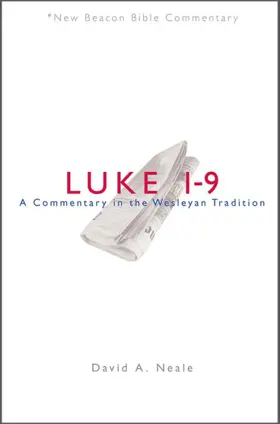

Luke 1–9: A Commentary in the Wesleyan Tradition
in New Beacon Bible Commentary
Pages
224
Publisher
Beacon Hill Press of Kansas City
Published
3/21/2011
ISBN-13
9780834124080
Since the author's name appears nowhere in its narrative, the Gospel is an anonymous work. The attribution to someone named Luke is a matter of tradition for which the external evidence is sparse. Several early manuscripts indicate that the attribution of this Gospel to Luke was already common in the late second and early third century
Reviews
David Neale's command of the scriptures is obviously impeccable as is demonstrated in this commentary. He is able to spot passages in Luke that depend on certain passages in the Old Testament. Usually, Luke's use of the Old Testament comes in the way of paraphrase or familiar verbiage. I never noticed them until Neale pointed them out in this commentary. He is also very comfortable with the Deuterocanonical and Pseudepigraphic literature. He has spotted several places in the book of Luke that seem to tip their hats to passages in those places.
Some of his observations are quite brilliant, in my humble opinion. For example, when the seventy(-two) missionaries returned, he observed some things I have never before noticed:
Luke 10:18 "Luke, however, never explicitly refers to the preexistence of Jesus. Nor does he generally speak like an apocalyptic figure in Luke. It is more likely that the statement hyperbolically characterizes the disciples' success in exorcism as affecting the demise of Satan himself. ... Thus, the best interpretive position is that the disciples' successful exorcisms symbolically announce the defeat of Satan...." Neale adds to this view in his study of chapter 21.
Luke 10:20 "Here in Luke, Satan is dethroned by the healing and preaching of the disciples. this is a present reality, evidence of the presence of the kingdom of God in their midst (see Luke 17:21)" (vol. 2, p. 63).
On Luke 15:25-32, he says, "Jesus replaces an obsolete politics of holiness with a new policy of compassion. Holy community was to be based on openness to the ritually and morally impure. Communities were not to be founded on exclusion (closedness) but on inclusion (openness). The wideness of grace at the heart of Luke's Gospel radically challenges the theology of holiness as separation. Love and inclusion replace a theology of holiness based on separation with one based on compassion" (vol. 2, p. 144).
On some of Neale's positions, he does believe in the source hypothesis. He believes in the Q tradition but he does not admit it outright until p. 159 of volume 1.
As do most Christians, Neale believes that Jesus' death was God's will (p. 215-216, volume 1).
He does occasionally skip some passages that I wish he would have mentioned - even to say that hes has no idea how to handle them. In volume 2, he never mentioned the significance of the vultures in Luke 17:37. He does not provide a decent explanation for the meaning of Luke 21:25-26. Luke is clearly segueing from the destruction of Jerusalem to the "coming of the Son of Man" but it is not clear how the segue is to be understood. (I am really reaching to find something to criticize. My only point is that the commentary is not exhaustively thorough' but it hits on many themes that are often overlooked by commentators).
My biggest complaint is that these two volumes are published in two volumes rather than one. There is no reason that the content of these two volumes. Thirty-seven introductory pages in volume 1 are repeated in volume 2.
There is a fairly large amount of typographical errors, primarily in the area of scripture citations. When I looked them up, it seemed that the occasional cross-reference did not have the content that it was purported to have, or the reference did not exist at all! Most of the typos I was able to figure out and they appeared to be cases in which the author got his fingers on the wrong number keys when typing... almost like he was typing in the dark. I don't know if the whole series was edited the same way; but a closer editing method would have helped with the occasional confusing reference. I only found seven or eight; but that is seven or eight mistyped references.
